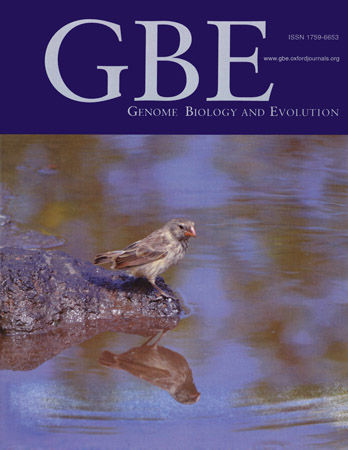
Biology Under Cover Abstract
Selected Journal & Book Covers from SBS Faculty
Epigenetics and the Evolution of Darwin's Finches
Skinner, M. A., C. Gurerrero-Bosagna, Md M. Haque, E. E. Nilsson, J. A. H. Koop, Sarah A. Knutie and D. H. Clayton
Commentary
The prevailing theory for the molecular basis of evolution involves genetic mutations that ultimately generate the heritable phenotypic variation on which natural selection acts. However, epigenetic transgenerational inheritance of phenotypic variation may also play an important role in evolutionary change. This study was designed to compare epigenetic changes among several closely related species of Darwin’s finches, a well-known example of adaptive radiation. Erythrocyte DNA was obtained from five species of sympatric Darwin’s finches that vary in phylogenetic relatedness. Genome-wide alterations in genetic mutations using copy number variation (CNV) were compared with epigenetic alterations associated with differential DNA methylation regions (epimutations). Epimutations were more common than genetic CNV mutations among the five species; furthermore, the number of epimutationsincreased monotonically with phylogenetic distance. Interestingly, the number of genetic CNV mutations did not consistently increase with phylogenetic distance. The number, chromosomal locations, regional clustering, and lack of overlap of epimutations and genetic mutations suggest that epigenetic changes are distinct and that they correlate with the evolutionary history of Darwin’s finches. Since publication in 2014, the paper has been cited widely.
Abstract
The prevailing theory for the molecular basis of evolution involves genetic mutations that ultimately generate the heritable phenotypic variation on which natural selection acts. However,(cont.) epigenetic transgenerational inheritance of phenotypic variation may also play an important role in evolutionary change. A growing number of studies have demonstrated the presence of epigenetic inheritance in a variety of different organisms that can persist for hundreds of generations. The possibility that epigenetic changes can accumulate over longer periods of evolutionary time has seldom been tested empirically. This study was designed to compare epigenetic changes among several closely related species of Darwin’s finches, a well-known example of adaptive radiation. Erythrocyte DNA was obtained from five species of sympatric Darwin’s finches that vary in phylogenetic relatedness. Genome-wide alterations in genetic mutations using copy number variation(CNV) were compared with epigenetic alterations associated with differential DNA methylation regions (epimutations). Epimutations were more common than genetic CNV mutations among the five species; furthermore, the number of epimutations increased monotonically with phylogenetic distance. Interestingly, the number of genetic CNV mutations did not consistently increase with phylogenetic distance. The number, chromosomal locations, regional clustering, and lack of overlap of epimutations and genetic mutations suggest that epigenetic changes are distinct and that they correlate with the evolutionary history of Darwin’s finches. The potential functional significance of the epimutations was explored by comparing their locations on the genome to the location of evolutionarily important genes and cellular pathways in birds. Specific epimutations were associated with genes related to the bone morphogenic protein, toll receptor, and melanogenesis signaling pathways. Species-specific epimutations were significantly overrepresented in these pathways. As environmental factors are known to result in heritable changes in the epigenome, it is possible that epigenetic changes contribute to the molecular basis of the evolution of Darwin’s finches.
